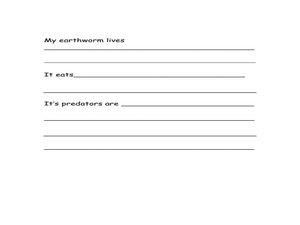Curated OER
Nuts About Peanuts
First graders explore peanuts. In this peanut lesson, 1st graders examine the parts of peanut plants and identify them. Students plant their own peanut plants and chart their growth.
Curated OER
Flower Power
Students use video learning to explore how flowers make seeds and dissect their own flower, and make a flower with its reproductive parts out of construction paper.
Curated OER
Exploring Ecosystems
Fourth graders create an ecosystem as a class. They have already produced smaller ones. They use a pond or something similar on school grounds to meet the needs of certain plants and animals of their ecosystem. Specifically created will...
Curated OER
Galapagos: Beyond Darwin
Young scholars identify plants and animals endemic in their local area after learning about the plants and animals of the Galapagos Islands. In this plants and animals lesson plan, students create an endemic garden on school grounds.
Curated OER
Classification 2: A Touch of Class
Young scholars examine how many kinds of living things (e.g. plants and animals) can be sorted into groups in many ways using various features to decide which things belong to which group and that classification schemes vary with purpose.
Curated OER
You Can Depend on Me
Students identify how they depend on others, and examine and discuss the images on the California Quarter Reverse. They view and discuss images of various habitats, complete a Habitat Research worksheet, and create a habitat diorama.
Curated OER
Dinnertime On The Reef
Students identify the main parts of a coral reef. They describe a coral reef food chain.
Curated OER
The Intertidal Zone
Young scholars research the diverse animal and plant life that inhabit the intertidal zones along the Pacific rocky coast. As students progress through this lesson, they begin to recognize distinct behaviors, adaptations, and...
Curated OER
World Climate Growing Zones
Young scholars create a map showing where crops would be grown around the world. In this crops lesson plan, students show how the world climate would produce different parts of the world at different times. Young scholars fill out...
Curated OER
Earthworms and Making a Wormery
Students explore the environment by researching insects. In this earthworm lesson, students utilize soil and plexiglass to build a see through wormery in which students can observe the worms at work. Students identify the benefits of...
Curated OER
Pond and Pond Organisms
Students explore pond ecosystems. In this pond organism activity, students will use pond water and a plastic bad in order to locate and identify freshwater organisms. The activity is designed for younger grades, but includes an...
Curated OER
Animal Diversity
Young scholars explore biology by completing science worksheets in class. In this animal anatomy lesson, students read the book The Adventures of Marco and Polo and identify the animals mentioned in it. Young scholars examine a real life...
Curated OER
Honey Bee Biology
Students review the basic parts of an insect and explore the anatomical characteristics of a honey bee. The second part of the lesson focuses on ways to identify a honey bee from other stinging insects.
Curated OER
Seahawk Educational & Environmental Discovery Program
Students identify and describe local poisonous plant/animals. They compare characteristics of three local ecosystems and describe common plants from different ecosystems; comparing shapes, colors, textures, and measuring sizes.
Curated OER
The Secret Garden
Students explore plants in science and England as they synthesize data from the book, "The Secret Garden in this twelve lessons unit. Comparisons between the nuturing needs of plants and humans are made.
Curated OER
Earth's Atmosphere and Temperature
Students explore the layers of earth's atmosphere and conduct an experiment to identify carbon dioxide. They construct models using styrofoam to represent molecules in the atmosphere's layers. To discover how sunlight efffects...
Curated OER
Let's Study Outdoors - Outdoor Classroom
Students research native plants. They identify the plant by scientific name, size, amount of water needed and color. Pupils measure and plot an area of school property. Students create an outdoor classroom. Additional cross curriculum...
Curated OER
Genetics Crossword
In this biology worksheet, students complete a crossword puzzle with 38 questions on genetics. They identify the different parts and functions of a flower.
Curated OER
Life in Sahara
Students explore the geography of the Sahara region of Africa and identify characteristics of a desert habitat. They explore the culture of the people living there and how it has adapted to desert life.
Curated OER
Treetures
Students identify the different forests of the world and some of the characteristics that differentiate them. They explore old magazines, calendars and photos and fill out a scavenger hunt worksheet.
Curated OER
Acid and Rain and Its Effects
Young scholars work in groups for up to three weeks to investigate the possibility of acid rain in your area and to investigate the damage that acid rain can do to buildings, monuments, and plants. Each group prepares a report to local...
Curated OER
Impact of Exotic Species on Lake Ecology
Students examine the effect of foreign species on various habitats. In groups, they identify the population dynamics of the zebra mussel. They calculate averages and graph data from Seneca Lake in New York. They develop hypothesis...
Curated OER
A Marsh-ian Restaurant
Second graders explore the marshland habitat. In this habitats instructional activity, 2nd graders view a video on marshlands and identify the plants and animals that live there. Students discuss the characteristics of the marshland...
Curated OER
Taxonomy
In this biology worksheet, students complete a crossword puzzle with 39 questions on taxonomy. They identify the different classification systems used in biology.

























